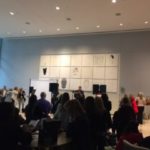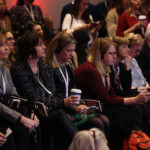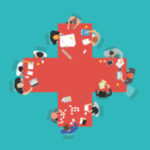
If you’re a data geek, chances are Tableau Software’s annual conference is your homecoming, Oscar night, and Super Bowl, all rolled into one. Tableau’s products turn raw data into engaging visualizations, and are used by a wide variety of businesses and other organizations — from Pfizer to Macy’s to the IRS — to look at their information in a new way. Think Excel meets Pixar (and not just because Pixar alum Pat Hanrahan helped develop the software).
Although Tableau’s software sells itself easily enough — 2013 revenues hit $232.4 million, up 82 percent from 2012 — a steady stream of customer events has also played a significant role in the company’s success. The largest of these events is the annual Tableau Conference, which this past Sept. 8–12 drew record attendance at the Washington State Convention Center (WSCC) in the company’s hometown of Seattle.
“Data should be cool. It should be a fun, engaging experience,” said Amy Barone, Tableau’s director of marketing events and engagement programs, as we snaked through a crowd of backpack-toting 2014 Tableau Conference attendees. I had just picked up my own Tableau backpack from Baggage Claim — an actual revolving baggage carousel set up on level four of the WSCC, near the registration area — and Barone was explaining how her team custom-designed the backpacks, from the padded laptop slot down to the zippers. It’s this creative attention to detail and let’s-have-fun-with-it approach that have earned the conference an almost cult-like following. This year, more than 5,100 tickets sold out six weeks prior to the event — “We cap attendance according to venue limitations,” Barone said — resulting in a waiting list of more than 1,200 people. The conference’s retail store, stocked with Tableau-emblazoned paraphernalia and swag, sold $30,000 in merchandise last year.
“We sold $10,000 at the end of yesterday,” Barone said as we walked by this year’s store, set up on level one of the WSCC’s Conference Center, across the street from the main building, “so we’ll see what happens this year.”
A DIFFERENT SET OF RULES
A big part of Tableau’s success is because its software is designed to foster creativity, helping users find a better way to visualize a complicated set of data, or just look at a problem in a different way. Because the company’s attendee base is made up of customers looking to master the software, Barone and her team approach the annual conference with the same open-mindedness. For example, they took an unorthodox approach to sponsorships this year.
“We did something a little crazy,” Barone said. “We needed to start opening up our sponsor packages, but we didn’t really know what the options were, so we offered a build-your-own-sponsorship package.” Options included basics such as booth space in the conference’s exhibit hall, but also offered sponsors an allowance to choose between a la carte programs, such as speaking opportunities. “I always read through sponsor perspectives [at other events] and thought, I don’t really care about half this stuff,” Barone said. “It went really well.”
Walking through the conference — where Convene was hosted by Visit Seattle — I felt a constant mood of fun and play permeating the atmosphere. Instead of a typical photo booth, a slow-motion video booth in the conference hub on level four captured costumed attendees goofing off between sessions. Periodically throughout the conference, I spied a camera-equipped drone shooting photos from above. DJs constantly spun music in break areas, and a Charge Cycle station let attendees hop on a stationary bike to power up their phones. “We want people to join our community,” Barone said. “We’re definitely open, we love ideas. People throw in their ideas all the time.”
Barone and her team approached the food-and-beverage program with a similar go-with-the-flow mindset. In addition to offering breakfast and lunch, Tableau satiated attendees, many of whom were operating on different schedules, with always-open alternatives sprinkled throughout the WSCC. Options included Bits & Bytes, self-service stations stocked with wraps, hummus packs, and salads; Re-Bar, which had counters equipped with outlets for charging; Bar Chart, an actual bar serving a heartier menu and, starting at 3 p.m., local wine and beer; and Wild Rye, a full-service cafe. Everything was free to attendees — included in the cost of registration — and the menus kept a consistently healthy focus.
Not that there weren’t challenges. “How do you feed 7,200 people in a space that seats 2,500? We created food anytime and anywhere,” said Marcus White, principal with MCW Events, who worked with Tableau to plan the conference. “The theory was that if we can keep people in the common areas and capture them before migrating to the meal hall and expo floor, we could really ease the compression during the lunch period. We did this by providing a true array of food options as they walked out of their sessions — mac and cheese from local cheese maker Beecher’s, wraps, salads, and hardboiled eggs. We really needed these grab ’n’ go stations to be true meal replacements, and it worked.”
Tableau also scheduled special networking-lunch sessions aimed at its largest audience segments in nearby partner hotels to divert more people at main meal times. “Of course, there was many a nail bitten waiting to see if this would work,” White said. “But I had a colleague who attended the conference and she said that she loved the option of not going into a regular meal line.”
FUN AND GAMES
“Every year, we’ve taken advantage of outdoor space,” Barone said. At the WSCC this year, Tableau turned a verdant outdoor terrace into the Data Playground, an AstroTurf-covered lounge decked out with kitschy lawn chairs, miniature golf, ping pong, cornhole, and iced-chai-tea refreshment stands. “Our team loves being creative,” Barone said. “It’s so important to go get fresh air, see the daylight, so you don’t get that second-half-of-the-day lull.”
Indeed, Barone and her planning staff attempted to push creative boundaries whenever possible, from small details such as scattering old-school jukeboxes loaded with music from Seattle bands in break areas, to coordinating big moments like a group of Tableau staff and leaders remotely ringing the New York Stock Exchange bell outside the WSCC on the first day of the conference.
Creativity spilled over into the planning team’s problem-solving as well. “‘Probotunities’ — problems that are really opportunities, as we like to call them,” White said. One example was accommodating the high number of special meal requests that Tableau received, from 11 percent of attendees. In addition to offering a generally healthy menu that listed all ingredients at every meal function, the team also stocked its self-service stations with special-request meals. “We worked really hard with our F&B manager at the WSCC to come up with interesting and innovative meals that were healthy,” White said. “We also emailed each person that had a special meal request with resources and meal-planning options, like specific locations where those with more severe food allergies could pick up their specially made meals. That way, our guests were not regulated to a children’s table in the back, but really felt heard and taken care of. In my 16 years of planning events, this is the first time that I’ve ever not had one food complaint escalated to me.”
Tableau’s educational components also leaned toward the alternative, often breaking out of the typical classroom-style format. One of the conference’s most popular events is the Iron Viz Championship, a live, Iron Chef–style competition in which contestants have 20 minutes to create the most engaging visualization using the same set of data. The competition takes place in what Barone calls “Tableau Stadium,” a ballroom that has been transformed into a sort of geek-ified sports arena. Also popular are appointments with the Tableau Doctors, where attendees receive one-on-one training with a Tableau expert. The “doctors” dress in white lab coats, and attendees can make appointments at booths that mimic first-aid stations.
THE BIG NIGHT OUT
The conference’s creative masterpiece, the Data Night Out – Appreciation Party, was a first not only for Tableau but also for Seattle. Data Night Out was the first private event ever to take over Seattle Center, an 84-acre campus that encompasses the city’s biggest attractions, including the Space Needle, the Frank Gehry–designed EMP Museum, and the new Chihuly Garden and Glass. Barone and her team booked an entirely local lineup of 13 music acts, including Sir Mix-A-Lot, who played the finale concert with the Seattle Rock Orchestra under the Space Needle. “You can spend a million bucks [on one big act],” Barone said, “or spend half that and get five stages of amazing local bands.”
In addition to sampling the concerts, attendees could wander through Seattle Center’s individual attractions, which closed down just for Tableau, or snack their way through the evening. Dozens of food options scattered throughout the venues reflected different themes — at the Space Needle, a spread of cheddar-topped bratwurst and American Kobe hotdogs; inside Chihuly Garden and Glass, tables of hand-rolled sushi and a DIY pho bar. A big challenge the planning team overcame were restrictions on alcohol. Because each venue had its own code, guests couldn’t carry drinks from one place to another, so Tableau set up “Drop Your Cup” stations at every venue exit.
Another challenge Tableau and Seattle solved together was how to get attendees to Seattle Center, which is about a mile away from the WSCC. Instead of limiting themselves to one option, they set up multiple modes of transportation, including private coaches, the Seattle Monorail, and Ducks — World War II–era amphibious landing crafts — all of which were complimentary for attendees. “It had never been done before,” said Kelly Saling, national account director for convention sales with Visit Seattle, “and it was a vision.”
When Visit Seattle first submitted its bid for Tableau 2014 a few years ago, it pitched the idea of using Seattle Center for a block party. “They know they’ve got a big party, and they’ve got to have it be a rocking big party. Where can we do that?” Saling said. “You lose the personality of what the city has to offer to some degree when you have to pick up and transport 6,000 people somewhere else. Seattle Center was close enough that we could capture that. They really wanted it to be a homecoming, and I think we hit the nail on the head.”
As Tableau’s hometown, Seattle played an important role in the conference. Barone used the city as a constant source of inspiration. On the first night of the conference, Tableau welcomed attendees with a homecoming-inspired reception, complete with a pep-rally kickoff, silent disco, and marching-band performance by Sound Wave, the official band of the Seattle Sounders, the city’s Major League Soccer team.
“That is [Tableau’s] personality,” said Saling, who along with Tom Norwalk, Visit Seattle’s president and CEO, worked on Tableau 2014 for more than four years. The company’s first few conferences were held in Seattle-area hotels, averaging 200 or so attendees, but then moved on to other cities and venues as demand grew. “It was a nail-biter,” Norwalk said of the planning process. “Because of how fast they were growing, there was a good chance they could just have shot right past our capabilities and we couldn’t handle it.”
But in the end, Tableau 2014 gave Seattle a moment to shine as a convention destination, with the new capacity of Seattle Center to host events like Data Night Out, and a growing hotel inventory and planned expansion of the WSCC on the horizon. “Business like this isn’t a dime a dozen,” Saling said. “We had an opportunity to showcase and earn it. It’s important. They live here, we know these people.”
“This [conference] tied all of the destination’s venues together through [Tableau’s] own creativity and our ability to execute it,” said Krista Daniel, CMP, director of event services at the WSCC. “The venues have independently done really great things for all of our events, but this [conference] has really tied it all together as a single entity really more so than in the past.”



